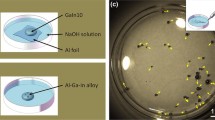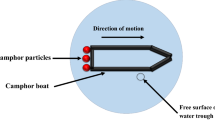Abstract
Bubbles often play a critical role in micro-systems involving Janus catalytic micro-motors (JCMs). Here, we examine some peculiar behaviors of the formation, growth, and collapse of the bubbles observed in recent experiments, in which JCM-laden droplets were dispensed on solid substrates and mixed with droplets of hydrogen peroxide solution. First, no oxygen bubble is visible near isolated JCMs when their size is smaller than a certain threshold, but bubbles can form and grow between a circular ring of small JCMs without touching any JCMs. Using analytical modeling and numerical simulations, we show that the lack of bubble formation near small, isolated JCMs originates from the low supersaturation of oxygen near their surface, which is caused by the efficient dissipation of oxygen molecules generated on their surface toward the bulk solution. In contrast, a cluster of small JCMs can collectively produce high enough oxygen supersaturation near the cluster to nucleate a bubble. Second, the radius of these bubbles grows following a power law of \(R \sim t^{0.7}\), rather than the typical \(R \sim t^{1/2}\) or \(R \sim t^{1/3}\) laws for the growth of bubbles driven by simple diffusion or direct gas injection into the bubble. Our numerical simulations showed that this anomalous growth law is a result of the cooperative action of the oxygen supersaturation-driven bubble growth and the mutual motion between the JCMs and the growing bubble. Finally, once a bubble grows to its maximal size, it collapses far more rapidly than the time scale expected for bubbles that contain non-condensable gas and exist in bulk liquids. Our scale analysis and numerical simulations show that this rapid collapse can be explained by the coalescence of the bubble with the air–liquid interface of the liquid film.








Similar content being viewed by others
References
Anderson JL (1989) Colloid transport by interfacial forces. Annu Rev Fluid Mech 21:61–99
Bankoff S (1958) Entrapment of gas in the spreading of a liquid over a rough surface. AIChE J 4:24–26
Baraban L, Makarov D, Streubel R, Mönch I, Grimm D, Sanchez S, Schmidt OG (2012) Catalytic janus motors on microfluidic chip: deterministic motion for targeted cargo delivery. ACS Nano 6:3383–3389
Blanchette F, Bigioni TP (2006) Partial coalescence of drops at liquid interfaces. Nat Phys 2:254–257
Blander M, Katz JL (1975) Bubble nucleation in liquids. AIChE J 21:833–848
Brandon NP, Kelsall GH (1985) Growth-kinetics of bubbles electrogenerated at microelectrodes. J Appl Electrochem 15:475–484
Buehl WM, Westwater JW (1966) Bubble growth by dissolution—influence of contact angle. AIChE J 12:571–576
Burdick J, Laocharoensuk R, Wheat PM, Posner JD, Wang J (2008) Synthetic nanomotors in microchannel networks: directional microchip motion and controlled manipulation of cargo. J Am Chem Soc 130:8164–8165
Debenedetti PG (1996) Metastable liquids: concepts and principles. Princeton University Press, Princeton
Enriquez OR, Sun C, Lohse D, Prosperetti A, van der Meer D (2014) The quasi-static growth of co2 bubbles. J Fluid Mech 741:R1
Epstein PS, Plesset MS (1950) On the stability of gas bubbles in liquid–gas solutions. J Chem Phys 18:1505–1509
Fletcher NH (1958) Size effect in heterogeneous nucleation. J Chem Phys 29:572–576
Frankel AE, Khair AS (2014) Dynamics of a self-diffusiophoretic particle in shear flow. Phys Rev E 90:013030
Gao W, Uygun A, Wang J (2012) Hydrogen-bubble-propelled zinc-based microrockets in strongly acidic media. J Am Chem Soc 134:897–900
Gibbs JG, Zhao Y-P (2009) Autonomously motile catalytic nanomotors by bubble propulsion. Appl Phys Lett 94:163104
Golestanian R, Liverpool TB, Ajdari A (2005) Propulsion of a molecular machine by asymmetric distribution of reaction products. Phys Rev Lett 94:220801
Guix M, Mayorga-Martinez CC, Merkoci A (2014) Nano/micromotors in (bio) chemical science applications. Chem Rev 114:6285–6322
He P, Liu Y, Qiao R (2015) Fluid dynamics of the droplet impact processes in cell printing. Microfluid Nanofluid 18:569–585
Howse JR, Jones RAL, Ryan AJ, Gough T, Vafabakhsh R, Golestanian R (2007) Self-motile colloidal particles: from directed propulsion to random walk. Phys Rev Lett 99:048102
Hsu Y (1962) On the size range of active nucleation cavities on a heating surface. J Heat Transfer 84:207–213
Huang WJ, Manjare M, Zhao YP (2013) Catalytic nanoshell micromotors. J Phys Chem C 117:21590–21596
Incropera FP, DeWitt DP (2002) Fundamentals of heat and mass transfer, 5th edn. Wiley, New York
Jones S, Evans G, Galvin K (1999) Bubble nucleation from gas cavities—a review. Adv Colloid Interface Sci 80:27–50
Jurado-Sanchez B et al (2015) Self-propelled activated carbon janus micromotors for efficient water purification. Small 11:499–506
Li J et al (2015) Self-propelled nanomotors autonomously seek and repair cracks. Nano Lett 15:7077–7085
Liu XY (2000) Heterogeneous nucleation or homogeneous nucleation? J Chem Phys 112:9949–9955
Liu D, Lee P-S, Garimella SV (2005) Prediction of the onset of nucleate boiling in microchannel flow. Int J Heat Mass Transf 48:5134–5149
Manjare M, Yang B, Zhao YP (2012) Bubble driven quasioscillatory translational motion of catalytic micromotors. Phys Rev Lett 109:128305
Manjare MT, Yang F, Qiao R, Zhao Y (2015) Marangoni flow induced collective motion of catalytic micromotors. J Phys Chem C 119:28361–28367
Matsumoto M, Tanaka K (2008) Nano bubble—size dependence of surface tension and inside pressure. Fluid Dyn Res 40:546–553
Michelin S, Lauga E (2014) Phoretic self-propulsion at finite péclet numbers. J Fluid Mech 747:572–604
Moran JL, Posner JD (2010) Locomotion of electrocatalytic nanomotors due to reaction induced charge autoelectrophoresis. Phys Rev E 81:065302
Moran JL, Posner JD (2011) Electrokinetic locomotion by reaction induced charge auto-electrophoresis. J Fluid Mech 680:31–66
Moran JL, Posner JD (2014) Role of solution conductivity in reaction induced charge auto-electrophoresis. Phys Fluids 26:42001
Mou F, Chen C, Zhong Q, Yin Y, Ma H, Guan J (2014) Autonomous motion and temperature-controlled drug delivery of mg/pt-poly (n-isopropylacrylamide) janus micromotors driven by simulated body fluid and blood plasma. ACS Appl Mater Interfaces 6:9897–9903
Mou F, Li Y, Chen C, Li W, Yin Y, Ma H, Guan J (2015) Single-component tio2 tubular microengines with motion controlled by light-induced bubbles. Small 11:2564–2570
O’Shaughnessy SM, Robinson AJ (2008) Numerical investigation of bubble induced marangoni convection: some aspects of bubble geometry. Microgravity Sci Technol 20:319–325
Orozco J et al (2013) Molecularly imprinted polymer-based catalytic micromotors for selective protein transport. J Am Chem Soc 135:5336–5339
Pavlick RA, Sengupta S, McFadden T, Zhang H, Sen A (2011) A polymerization-powered motor. Angew Chem 123:9546–9549
Plesset MS, Prosperetti A (1977) Bubble dynamics and cavitation. Annu Rev Fluid Mech 9:145–185
Popescu MN, Dietrich S, Oshanin G (2009) Confinement effects on diffusiophoretic self-propellers. J Chem Phys 130:194702
Rein M (1993) Phenomena of liquid drop impact on solid and liquid surfaces. Fluid Dyn Res 12:61
Sánchez S, Soler L, Katuri J (2015) Chemically powered micro-and nanomotors. Angew Chem Int Ed 54:1414–1444
Sengupta S, Ibele ME, Sen A (2012) Fantastic voyage: designing self-powered nanorobots. Angew Chem Int Ed 51:8434–8445
Soler L, Magdanz V, Fomin VM, Sanchez S, Schmidt OG (2013) Self-propelled micromotors for cleaning polluted water. ACS Nano 7:9611–9620
Solovev AA, Mei YF, Urena EB, Huang GS, Schmidt OG (2009) Catalytic microtubular jet engines self-propelled by accumulated gas bubbles. Small 5:1688–1692
Wang S, Wu N (2014) Selecting the swimming mechanisms of colloidal particles: bubble propulsion versus self-diffusiophoresis. Langmuir 30:3477–3486
Watanabe H, Suzuki M, Inaoka H, Ito N (2014) Ostwald ripening in multiple-bubble nuclei. J Chem Phys 141:234703
Wu M, Cubaud T, Ho C-M (2004) Scaling law in liquid drop coalescence driven by surface tension. Phys Fluids 16:L51–L54
Acknowledgements
The authors gratefully acknowledge support by the National Science Foundation (ECCS-1,303,134 and ECCS-1464146).
Author information
Authors and Affiliations
Corresponding author
Electronic supplementary material
Below is the link to the electronic supplementary material.
Rights and permissions
About this article
Cite this article
Yang, F., Manjare, M., Zhao, Y. et al. On the peculiar bubble formation, growth, and collapse behaviors in catalytic micro-motor systems. Microfluid Nanofluid 21, 6 (2017). https://doi.org/10.1007/s10404-016-1840-0
Received:
Accepted:
Published:
DOI: https://doi.org/10.1007/s10404-016-1840-0




